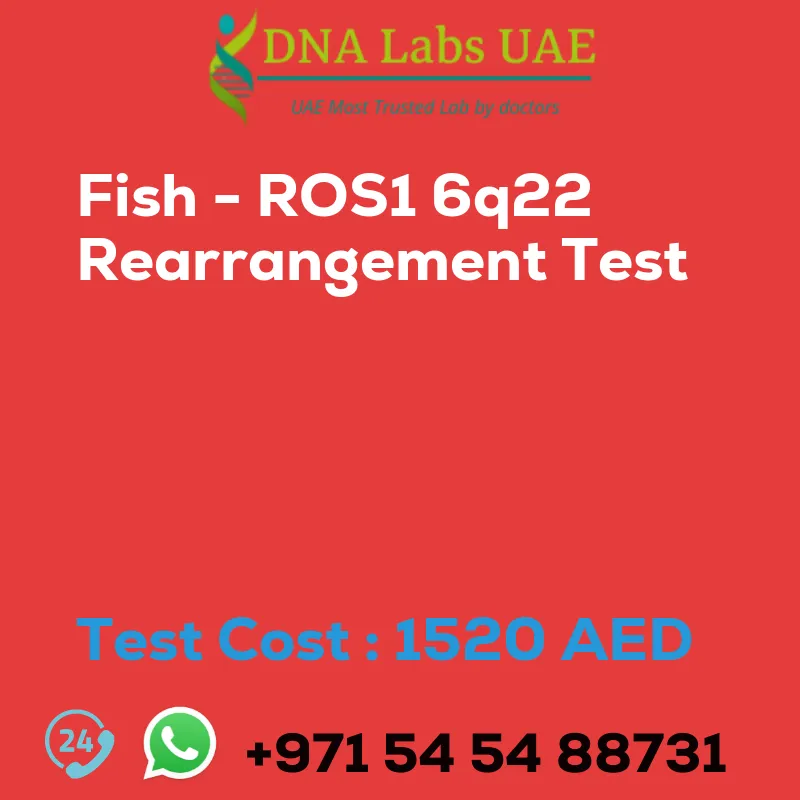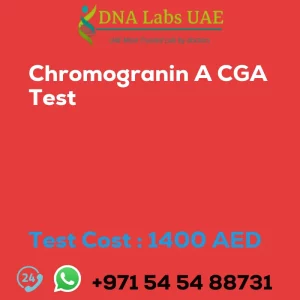FISH – ROS1 6q22 REARRANGEMENT Test
At DNA Labs UAE, we offer the FISH – ROS1 6q22 REARRANGEMENT Test for diagnosing genetic rearrangements in the ROS1 gene. This test is particularly important for patients with non-small cell lung cancer (NSCLC) and certain types of glioblastoma.
Test Details
The FISH – ROS1 (6q22) rearrangement test is a diagnostic test used to detect rearrangements in the ROS1 gene located on chromosome 6q22. Rearrangements in this gene have been found in various cancers, including NSCLC and glioblastoma.
The FISH technique is used in this test, where fluorescently labeled DNA probes specific to the ROS1 gene are applied to a patient’s tissue sample. If a rearrangement has occurred, the probes will bind to the abnormal fusion gene, resulting in a fluorescent signal that can be visualized under a microscope.
Test Cost
The cost of the FISH – ROS1 6q22 REARRANGEMENT Test is AED 1520.0.
Symptoms and Diagnosis
Patients who may benefit from this test are those who exhibit symptoms of non-small cell lung cancer or certain types of glioblastoma. Diagnosis of ROS1 rearrangements can be done through the FISH – ROS1 6q22 REARRANGEMENT Test, along with other methods such as immunohistochemistry and next-generation sequencing.
Test Requirements
In order to perform the FISH – ROS1 6q22 REARRANGEMENT Test, we require a formalin-fixed paraffin-embedded tissue block containing at least 10% tumor tissue. The sample should be shipped at room temperature. Additionally, a duly filled Chromosome & FISH analysis Requisition Form (Form 17) is mandatory.
Report Delivery
Sample delivery should be made daily by 4 pm. The report will be delivered within 4 working days.
Test Department and Doctor
The FISH – ROS1 6q22 REARRANGEMENT Test is conducted in our CYTOGENETICS department and is recommended by oncologists.
It is important to note that the FISH – ROS1 6q22 REARRANGEMENT Test is just one of several methods used to detect ROS1 rearrangements. Other methods include immunohistochemistry (IHC) and next-generation sequencing (NGS). These tests may be used in combination to provide a more comprehensive analysis of ROS1 rearrangements in cancer patients.
If you suspect you may have a ROS1 rearrangement, contact DNA Labs UAE to schedule your FISH – ROS1 6q22 REARRANGEMENT Test today.
| Test Name | FISH – ROS1 6q22 REARRANGEMENT Test |
|---|---|
| Components | |
| Price | 1520.0 AED |
| Sample Condition | Submit Formalin fixed paraffin embedded tissue block. Ship at room temperature. Tissue block must contain 10% tumor tissue. Duly filled Chromosome & FISH analysis Requisition Form (Form 17) is mandatory. |
| Report Delivery | Sample Daily by 4 pm; Report 4 Working days |
| Method | FISH |
| Test type | Cancer |
| Doctor | Oncologist |
| Test Department: | CYTOGENETICS |
| Pre Test Information | Duly filled Chromosome & FISH analysis Requisition Form (Form 17) is mandatory. |
| Test Details |
The FISH – ROS1 (6q22) rearrangement test is a diagnostic test used to detect rearrangements in the ROS1 gene located on chromosome 6q22. This gene encodes for a receptor tyrosine kinase that plays a role in cell growth and survival. Rearrangements in the ROS1 gene have been found in various cancers, including non-small cell lung cancer (NSCLC) and certain types of glioblastoma. These rearrangements result in the fusion of the ROS1 gene with other genes, leading to the production of abnormal fusion proteins with oncogenic properties. The FISH (Fluorescence In Situ Hybridization) technique is used to detect these rearrangements. In this test, fluorescently labeled DNA probes specific to the ROS1 gene are applied to a patient’s tissue sample. If a rearrangement has occurred, the probes will bind to the abnormal fusion gene, resulting in a fluorescent signal that can be visualized under a microscope. The FISH – ROS1 (6q22) rearrangement test is particularly important in identifying patients who may benefit from targeted therapy with ROS1 inhibitors. These inhibitors specifically target the abnormal fusion protein produced by the rearranged ROS1 gene, helping to inhibit cancer growth and improve patient outcomes. It is important to note that the FISH – ROS1 (6q22) rearrangement test is just one of several methods used to detect ROS1 rearrangements. Other methods include immunohistochemistry (IHC) and next-generation sequencing (NGS). These tests may be used in combination to provide a more comprehensive analysis of ROS1 rearrangements in cancer patients. |







